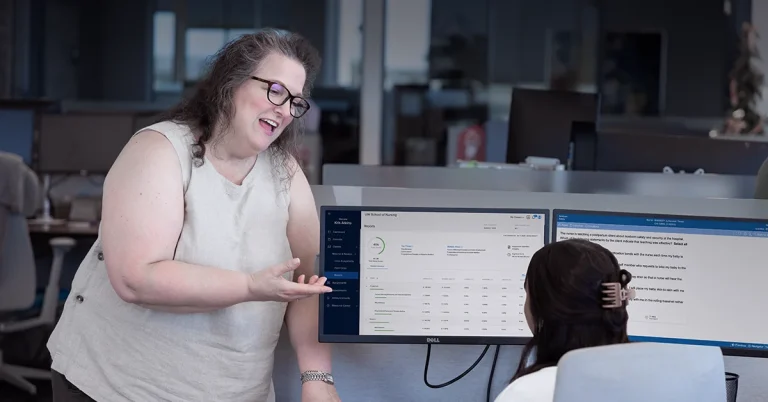The much awaited 2022 NCLEX Examination Candidate Bulletin has been released, and nursing students are eager to see the new information for registration, scheduling, and all things related to their upcoming NCLEX exams. In this article, we will review the latest information from the National Council of State Boards of Nursing® (NCSBN®) to help you in your preparation for this high-stakes licensure exam.
What Is the NCLEX?
The NCLEX-RN and NCLEX-PN exams are computer adaptive exams that assess the skills, knowledge, and abilities of candidates that are essential for the safe and effective practice of entry-level nursing. NCLEX results are how nursing regulatory bodies determine whether a candidate is ready for clinical practice and can, therefore, obtain licensure.
Because of the high stakes nature of these exams, it is advisable to practice with NCLEX-style practice questions and use a quality learning tool for NCLEX prep in the months leading up to your exam.
How To Register for the NCLEX
The NCSBN lists seven steps in the registration process:
- Submit an application for licensure with the nursing regulatory body (NRB) where you wish to be licensed.
- Meet all requirements of that NRB in order to be eligible to take the NCLEX.
- Register with Pearson VUE to take the NCLEX.
- Receive an NCLEX Registration Acknowledgement (this will come in the form of an email from Pearson VUE).
- In the Pearson VUE system, the NRB makes you eligible to test.
- Receive an email from Pearson VUE with your Authorization to Test (ATT)
- Schedule your NCLEX exam with Pearson VUE
How Much Does It Cost To Register for the NCLEX?
According to the NCLEX Examination Candidate Bulletin, the registration costs in 2022 are as follows:
The registration fee is $200 for candidates seeking licensure in the U.S. If you change your nursing regulatory body after registering, there is an additional fee of $50, and if you change your exam type (RN/PN) after registering, there is also an additional $50 fee.
The registration fee is $360 CAD for candidates seeking licensure in Canada, with an additional international scheduling fee of $150 CAD. If you change your exam language (English/French) after registering, there is an additional $50 CAD fee.
The registration fee is $200 USD for candidates seeking licensure in Australia, with an additional international scheduling fee of $150 USD. If you change your nursing regulatory body after registering, there is an additional fee of $50 USD.
Note: Your nursing regulatory body (NRB) also charges a fee for initial licensure. These fees vary from state to state. There are no refunds granted for NCLEX registration fees.
How Do I Register for the NCLEX?
There are two ways to register for the NCLEX exam: Internet Registration and Telephone Registration.
- For Internet Registration, visit the NCLEX Candidate website: www.nclex.com/register.htm to register. An email address is required when you register online.
- For Telephone Registration, call Pearson VUE at 1-866-496-2539. An email address is also required when you register over the telephone.
What Can I Expect on My NCLEX Exam Day?
After months spent answering NCLEX-style questions during NCLEX prep, applying for licensure with a nursing regulatory body, registering for the NCLEX, and scheduling your exam . . . you will finally take the exam. Here are a few things to know about exam day . . .
Checking In for the NCLEX
It’s a good idea to arrive at your testing site a few minutes before your scheduled exam time. This diminishes stress on test day and ensures you don’t miss check-in. If you arrive late for your scheduled appointment, it’s possible you will not be permitted to take the exam on that day, and your nursing regulatory body will be informed.
When you arrive at the testing site for registration, three things will take place:
- You will be asked to present a valid acceptable identification.
- You will also be required to use a palm vein scan to present your digital signature.
- Your picture will be taken.
Personal belongings (e.g., phones, hats, coats, scarves, purses, backpacks, watches, large jewelry, electronic devices, etc.) are not permitted inside the testing room. Each testing site will provide a small, secure storage space for candidates outside of the testing room. Any personal items accessed during a break are subject for inspection by the test administrator (TA).
Length of Exam
You will be allowed up to five hours on exam day to complete your NCLEX exam. This time limit is the same for both the NCLEX-PN and NCLEX-RN exams.
Breaks During the Exam
There are two optional breaks allowed during the exam. Because NCLEX questions are challenging and require focused critical thinking, many candidates choose to take these optional breaks.
According to this year’s NCLEX Examination Candidate Bulletin, the first optional break is after two hours of testing, and the second optional break is offered after three-and-a-half hours of testing.
If you opt to take one or both of these breaks, you will be required to leave the testing room and provide a palm vein scan when returning from your break.
How and When Will I Receive My NCLEX Results?
Your NCLEX is scored by the computer at the completion of your exam, and the results are verified after they have been transmitted to Pearson VUE; therefore, every NCLEX exam is scored twice.
Even though your exam is first scored at the testing center, the NCLEX Candidate Bulletin emphasizes that no results are released at the testing center and the staff at the testing center have no access to testing results.
The results of your exam are available through the nursing regulatory bodies. You can expect to receive your results up to six weeks after the completion of your NCLEX (this varies among nursing regulatory bodies).
If you don’t want to wait up to six weeks to find out how you performed on the exam, you can get what the NCLEX Examination Candidate Bulletin calls an “unofficial” result after two business days. Finding out your unofficial result can be done through your candidate profile. Keep in mind that there is a fee for unofficial results and they are not available in every state.
If I Don’t Pass My NCLEX, What Does the NCLEX Candidate Bulletin Say About Retakes?
If you don’t pass your NCLEX exam the first time, don’t worry, you can always retake it.
The NCSBN allows you to retake the NCLEX up to eight times a year, but it is required that there be a minimum of 45 test-free days between each exam.
The NCLEX Examination Candidate Bulletin notes that the policy of being able to retake the NCLEX eight times a year is dependent on how many times your desired jurisdiction of licensure actually offers the exam each year. If you are unsure about the frequency of exam dates, contact your nursing regulatory body and inquire about their retake policy.
————————————————————————————————————————————-
Getting ready for an upcoming NCLEX exam? Let us help! Our industry-leading online learning tool incorporates NCLEX-style practice questions, detailed explanations, vivid illustrations, and customizable flashcards as part of our active learning process. It’s no surprise that nearly a million nursing students have used UWorld for their NCLEX exam preparation since we launched our nursing product in 2015. Check out UWorld Nursing today to see how we can prepare you for the test and for a lifetime of clinical success.
References:
2022 NCLEX examination candidate bulletin – ncsbn.org. (n.d.). Retrieved February 11, 2022, from https://ncsbn.org/2022_NCLEX_Candidate_Bulletin_English.pdf






